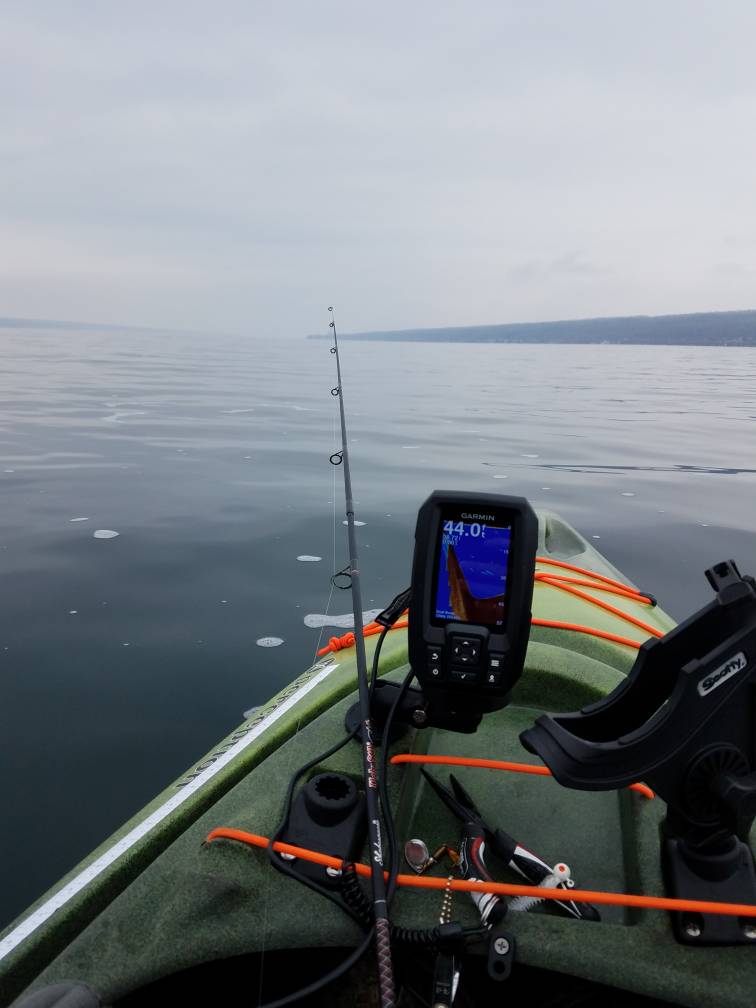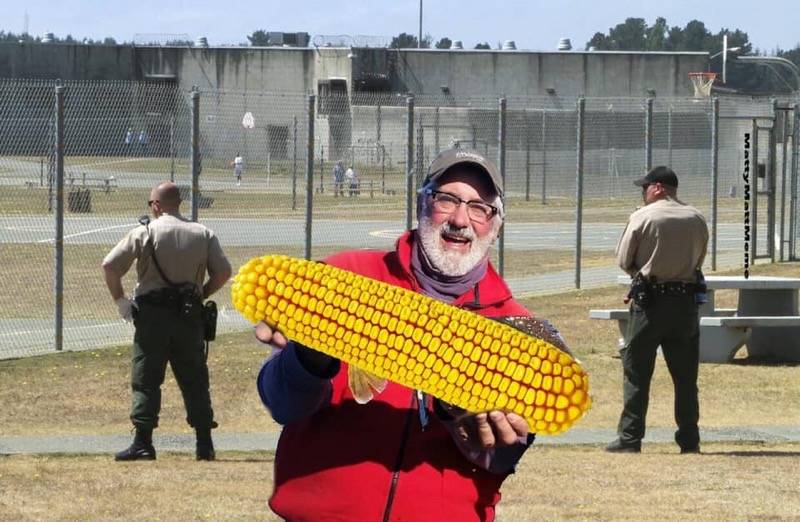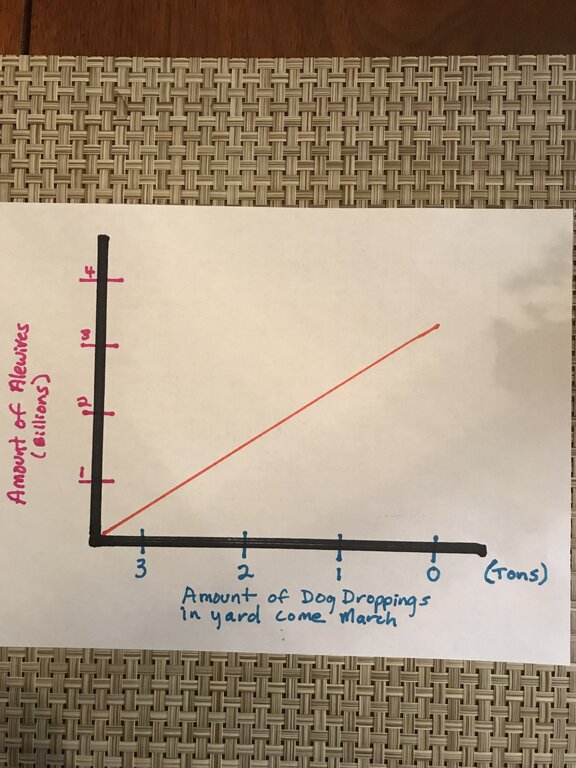

Lucky13
Members-
Posts
1,226 -
Joined
-
Last visited
Content Type
Profiles
Forums
Events
Gallery
Store
Everything posted by Lucky13
-
-
-
-
Come to think of it, there was a morning on the Salmon River about 35 years ago when the late Keith Smith, who guided for Whitakers, ran out of sacks and used a butt, and caught chrome on that for a while.
-
Sorry, I didn't see that someone had already posted this.
-
The illustration above shows spotting below the lateral line on an Atlantic as well as on the brown. It is not the best photo on the world for trying to do an ID, with the hand over the tail; and the low pixel count to the photo. We had a Region 7 Game Warden staying for summer vacation two doors down from us on Fourth Lake of the Fulton Chain for a while. The Landlock fishing was VERY good back then, and although there were a few browns in the lake stocked at the other end, we were sure we had never caught one. But Kevin said that he had to do the anal fin ray count on every fish he examined when he got assigned to patrol Lake Ontario or tribs, as none of the indicators other than internal and the ray count was conclusive. I am not sure what you see as anemic, as I thought the fish was healthy at least weight for length. We see a lot of skinny LLS in the 'daks usually because they are experiencing a down smelt year and are substituting baby perch. Maybe the color?
-
DEC: Anglers' Report Confirms New York's World-Class Freshwater Fishing New York's Freshwater Sportfisheries Generate More Than $2 Billion a Year and Support More Than 10,000 Jobs New York State Department of Environmental Conservation (DEC) Commissioner Basil Seggos today announced that the state's world-class fishing opportunities continue to draw anglers from near and far to New York's many productive freshwater sportfisheries. New data on angler effort, patterns, preferences, and attitudes was released today as part of DEC's statewide survey of freshwater anglers, which helps DEC assess both the biological and human dimension aspects of managing New York's freshwater fisheries. "New York is privileged to have an amazing diversity of freshwater resources," Commissioner Seggos said. "From remote Adirondack brook trout streams and ponds to the magnificent Great Lakes, our state's freshwater fisheries are among the very best in North America. DEC is committed to effectively managing these resources to maintain high-quality angling opportunities and the recreational and economic benefits they provide. These survey results reinforce what New Yorkers already know-freshwater angling in New York State is not only alive and well, it's thriving-and this survey will help guide our efforts in the years to come." New York State offers world class fishing for a wide variety of cold water and warm water species. Whether it is smallmouth bass fishing on Lake Erie, brook trout fishing on a crystal-clear Adirondack lake, Pacific salmon fishing on Lake Ontario, fishing for stripers on the Hudson River, brown trout fishing on the Beaver Kill or fishing for panfish on a local pond, there is something special in New York for every angler. In its 2019 rankings, and for the first time ever, Bassmaster Magazine named the St. Lawrence River as the top bass fishing destination in the nation. DEC has surveyed its licensed freshwater anglers once every decade since 1973. The survey announced today was conducted in 2018, and summarizes the input provided by approximately 11,000 anglers that fished the freshwaters of New York State during the 2017 calendar year. Combined direct, indirect, and induced economic impacts of freshwater angling in New York State totaled an estimated $2.14 billion and supported 10,961 jobs in 2017. Of this total, out-of-state anglers contributed approximately 26 percent, or $564 million. Freshwater anglers spent an estimated $252 million at New York fishing destinations in 2017, and an additional $204 million was expended at home or while traveling to fishing destinations. Purchases of fishing equipment and fishing-related equipment such as boats, motors, etc., generated an estimated $1.8 billion in additional expenditures. Results of the survey revealed significant increases in angler effort for a number of waters when compared to a 2007 angler survey. The Saranac River experienced the greatest increase in angler effort (150 percent) as more anglers visited to fish primarily for smallmouth bass and brown trout. There was an increase of 141 percent in the number of anglers fishing Irondequoit Creek, a Lake Ontario tributary near Rochester, with a focus primarily on brown trout and steelhead. The Delaware River in southeastern New York has long been popular for trout fishing, and angler effort increased by about 140 percent from 2007. Conesus Lake saw an increase of 155 percent in angler activity, with northern pike, largemouth bass, and smallmouth bass among the lake's most popular species. Other waterbodies that experienced a marked increase in angling activity included Whitney Point Reservoir (76 percent), Lake Champlain (72 percent), and the Batten Kill (61 percent). Freshwater anglers enjoyed an estimated 19.89 million angler days in 2017 in New York's inland and Great Lakes waters, slightly more than a similar survey conducted for 2007. Many anglers fished for warmwater gamefish (44 percent), primarily largemouth and smallmouth bass. Coldwater gamefish were also popular (28 percent), including brown trout, rainbow trout, brook trout, steelhead, and Chinook salmon. Anglers fished primarily on inland lakes and ponds (49 percent), inland streams and rivers (25 percent), and the Great Lakes and their tributaries (22 percent). In his 2020 State of the State Address (leaves DEC website), Governor Cuomo proposed the Restore Mother Nature initiative, the nation's most aggressive program for significant habitat restoration and flood reduction. Restore Mother Nature will reduce flood risk and revitalize critical fish and wildlife habitats by connecting streams and waterways, right-sizing culverts and dams, restoring freshwater and tidal wetlands, reclaiming natural floodplains, restocking shellfish populations and upgrading fish hatcheries, preserving open space, conserving more forest areas, replanting more trees, reducing contamination from agricultural and stormwater runoff, and expanding renewable energy. One of the goals of the initiative is to make New York the top state for recreational fishing. As part of a proposed $3 billion Environmental Bond Act, New York would invest in its world-class fish hatcheries. The Governor's program will also improve New York's network of fishing access sites, hand launch boat sites, and public fishing rights with an emphasis on warmwater streams and rivers. Full results of DEC's Statewide Angler Survey can be found at DEC's website. www.dec.ny.gov/press/press.html
-
I am sure you are aware that as soon as you apply scent, for purposes of regulations, you are no longer fishing an artificial lure, but have crossed into the "dark side" of bait fishing. So if it is legal to fish bait, I just hang an egg sack off the "fly", generally a glo bug if I think bait is needed. I am considering using nitrile gloves on some days to see if I catch more fish, as I still persist in my dirty and unhealthful smoking habit, and I've never seen a fish with a cigar in its mouth. But I see lots f pinners hooking up while cranking on cigarettes and vapers, so it will just be an experiment.
-
Possibly the BEST argument for requiring Charter Operators to get a NYS Guides License as well as the "Livery Tag" from the Coast Guard. As it stands now NYSDEC has nearly no leverage over Federally licensed livery operators, about all they could do would be to pull his fishing license, if he has one..
-
-
Gill- presents a strong correlation. You are misinterpreting that as causative , i.e. since a is correlated to b, removal of b will cause something to happen to a. The first thing you are told when being taught inferential statistics is that the presence of a strong correlation is NOT considered proof of a causative relationship, only that there is some relationship.
-
-
-
I have 4 of them, ordered them from Cabela's, as stated they are very strong, adjustable for all kinds of attachment points, they work on the gunwales of my Old Town Sport and on the thwarts of my Raddison, even hold a fly rod. I do add a tether to them in case they loosen up, so they are tied to the boat, but they are a fine product.
-
In line spinners work great for Steelhead, but they have to have a single hook, and you might want a little heavier wire than is normally used.
-
More helpful information and commentary.
-
I would be surprised if NYSDEC didn't have some of the print guides with them this weekend. Or stop at a tackle shop that sells licenses, they should have one. Nice picture of Rose Gerych, the East end fish head counter until this year, and her daughter, with a steelhead on the cover.
-
If you use the same lb test and no leader, and you break off, there is a chance you will break off a lot of line. Not only is that expensive for you, now there is a lot of line hanging in the current downstream, helping to guide subsequent presentations to additional snags, or making you think you have a bite every time you go through that part of the run. If you were using a braid main line you can leave a wire like trap to cut up other folks waders, and your own. With a swivel tied to your main line and a lighter leader, you likely only lose the shorter leader, which can be pre-tied. Float is the same as bobber, you just carry extras, but the longer thinner floats work better than the old spherical red and white jobbies. Go to the Niagara show, you will likely find all this and someone who can talk to you about it there. Even if they are talking about Center Pinning, the terminal end is set up the same, admittedly with a lot of detail in the shot placement.
-
I was taught to be efficient and helpful, not just always be wise a** stroking my own ego!
-
Since you are already at the west end, you might learn a LOT Saturday from 11 to 2 from DEC or anytime from other presenters at the above function. As to Lures in the tributaries which include ALL streams (yes, even Cowsucker Creek!) that flow to Lake Ontario upstream to the first barrier impassable by fish (and not all streams have them). As Sk8man says, read the little book you got when you bought your license ( you did buy a license, I hope!). This is from the website regulations guide (http://www.eregulations.com/newyork/fishing/special-regulations-great-lakes-tributaries/) Lake Ontario tributary seasonal fishing regulations Seasonal fishing regulations apply September 1 to March 31. Fishing hours Fishing from one-half hour after sunset to one-half hour before sunrise is prohibited except in the Black River (Jefferson County) from Lake Ontario upstream to the Route 180 bridge in Dexter, where fishing is permitted at all times. Hook, leader and weight regulations Hooks: Only one hook with a single hook point is permitted, except as outlined below for floating lures and artificial flies. Hooks attached to any lure must be free-swinging, except on an artificial fly (see Definitions). An artificial fly (Definitions) can only have a single hook with no more than two hook points. Tandem artificial flies are not permitted. The gap between a hook’s shaft and point cannot exceed one-half inch. Use of hooks with added weight is prohibited, except artificial flies (Definitions) and jigs weighing no more than one-eighth ounce. Floating lures: A floating lure is a lure that floats at rest in water with or without any weight attached to the lure, leader or line. Can have multiple treble hooks. Any hooks on a floating lure must be attached to the lure by a ring or swivel except for artificial flies. The distance between the body of a floating lure and the points of any attached hooks shall not exceed one and one-half inches. Leaders and weights: The distance between the hook, artificial fly or lure and any weight attached to the line or leader, whether fixed or sliding, shall not exceed four feet. Any weight added to the line, leader, swivels, artificial fly or lure shall not hang lower than the hook when the line or leader is held vertically. Lower Niagara River regulations can be found on Great Lakes & Tributary Regulations. Salmon River regulations can be found on below. Lake Ontario Waters and Tributaries Exempted from Seasonal Tributary Regulations The following regulations apply except those listed in the table below: Water County Applicable Regulations Niagara River Erie & Niagara Upper Niagara River or Lower Niagara River regulations apply Round Pond, Buck Pond, Long Pond, Cranberry Pond, and Irondequoit Bay Monroe Lake Ontario regulations apply Sodus Bay Wayne Lake Ontario regulations apply South Sandy Pond Oswego Lake Ontario regulations apply Sections of Lake Ontario Tributaries Subject to Seasonal (Sept. 1 to Mar. 31) Regulations The following tributary sections are subject to seasonal fishing regulations described below during the period September 1 to March 31: Water County Portion of Tributary Subject to Special Regulations Eighteenmile Creek Niagara From the Route 18 bridge upstream to Burt Dam Oak Orchard Creek Orleans From the first power lines that are 1.9 miles upstream (south) of Route 18 bridge upstream to Waterport Dam Genesee River Monroe From the State Route 104 Bridge upstream to the Lower Falls. Sterling Creek Cayuga From Old State Road to impassable barrier upstream of Route 104A Sterling Valley Creek Cayuga From McIntyre Road to impassable barrier upstream of Route 104A Oswego River Oswego From the Utica Street bridge upstream to the Varick Dam Catfish Creek Oswego From the mouth upstream to dam at County Route 1 Black River Jefferson From the upstream tip of the lowermost island to Mill Street dam in Watertown All other tributaries All From the bridge closest to the mouth upstream to first barrier impassable by fish Examples of Legal Seasonal Fishing Rigs
-
DEC to Feature New Angler Outreach Programs at 2020 Greater Niagara Fishing and Outdoor Expo Jan. 17 - 19 Biologists to Host Open House and Present Updates on Status of Lake Erie and Lake Ontario Fisheries The New York State Department of Environmental Conservation (DEC) invites the public to check out its Bureau of Fisheries' expanded angler outreach programs at the upcoming Greater Niagara Fishing and Outdoor Expo, Jan. 17 to 19, at the Niagara Falls Conference and Event Center. "DEC is pleased to increase our outreach efforts at this year's Niagara Fishing and Outdoor Expo," said DEC Commissioner Basil Seggos. "This event provides an excellent opportunity for anglers to interact directly with the biologists who study and manage our Great Lakes and inland fisheries, and to talk one-on-one with fisheries managers about a variety of topics. New York offers numerous world-class fishing opportunities, and we invite anyone interested to come and learn more about the incredible sportfishing in New York's Great Lakes region and beyond." Freshwater fishing in New York State is thriving and generates significant economic benefits to local economies. In 2017, anglers fished more than 3.1 million days on New York's open Great Lakes waters, and an additional 850,000 days on Great Lakes tributaries. The combined economic impact exceeded $152 million in angler expenditures en route to and at fishing destinations. Anglers fished more than 1.3 million days on the Finger Lakes in 2017, generating a combined $29.9 million in expenditures. In addition to its annual informational booth at the event, DEC will host abbreviated versions of the fisheries "State of the Lake" meetings for Lake Erie and Lake Ontario that are typically held in March and May. Meetings will feature emerging results about walleye movement, creel survey results, habitat work, prey base, and record catch rates. Key members of Lake Erie and Lake Ontario fisheries management and research community will present information on management and assessment activities for prominent lake and tributary sport fisheries. Meeting times are: State of Lake Ontario Fisheries meeting - Friday, Jan. 17, 6 to 7 p.m. State of Lake Erie Fisheries meeting - Friday, Jan. 17, 7 to 8 p.m. Billed as a top attraction at this year's expo, DEC will host a unique "Open House" program on Saturday, Jan. 18, from 11 a.m. to 2 p.m., during which expo attendees can talk one-on-one with subject matter experts on a variety of the State's fisheries management topics, including: Lake Ontario - open lake; Lake Ontario tributaries and Salmon River; Lake Erie and tributaries; Niagara River; St. Lawrence River; Great Lakes fish production and stocking; Finger Lakes; Recruiting more women to fishing; Trout stream management; and Environmental Law Enforcement. To learn more about this event, visit the Niagara Fishing Expo website. http://www.dec.ny.gov/press/press.html
-
Lures are limited in LO tribs for much of the year, must have a free swinging single point hook, except a 1/8 or less oz jig, or a floating lure. You are best to Study the regulations guide to become familiar with what is kosher and not kosher, and when. Probably the easiest way to start is with a spinning rod and float, distance between the float and bait determined by the approximate depth of the run you choose to fish, and salmon eggs or artificial bait, like yarn or plastics, or beads, and enough shot to sink them to the depth allowed by the float. Try these links for more info. http://www.dec.ny.gov/outdoor/62202.html http://www.dec.ny.gov/outdoor/37926.html
-

New Gun laws getting voted on tomorrow in NY
Lucky13 replied to fisherman21's topic in Big / Small Game
The requirement that a fire arm purchaser have a hunting license reveals a complete ignorance of the reason for the second amendment on the part of the bill's sponsor(s). A "well regulated militia" is what threw King George out when he became too tyrannical. While your .30-.06, or even an AK, are hardly going to win out over an A-10, the opportunity to fight tyranny is still there. Totally disarmed, like the German and Poles under the Nazis, not so much. Hun ting, and personal protection, are just side benefits of the amendment. I would hope that even the Emperor would be able to see that the court challenges to much of this will result in declarations of unconstitutionality and involve great expense to the state, and will not sign them to save some money. -

New Gun laws getting voted on tomorrow in NY
Lucky13 replied to fisherman21's topic in Big / Small Game
Take a look at San Francisco, that is what we will be seeing here in a few years. Car Break ins under $950.00 in value result in no action and release of the perpetrator. Smash and grab cases require the car owner to prove that the car was locked, in California, your property is no longer your property, We in NYS are not far behind. -
When I lived there in the seventies, the Johnson City Wastewater Treatment Plant would blow out to the river with great regularity, and there would be advisories posted to not handle or especially eat fish from the "urban" side of the river downstream to Owego. I would think DEC would have mandated upgrades in the intervening 40-50 years. But you are downstream from large agricultural areas, so , along with the mud, you could also encounter manure runoff, and if the Susq was muddy, it had been raining somewhere upstream recently, in dry spells it still flows very clear (based on being down there last spring, and also using the Genesee as a reference for clarity). I'm told access is more difficult than it used to be, but where is that NOT the case? Too bad you picked a poor conditions day.






